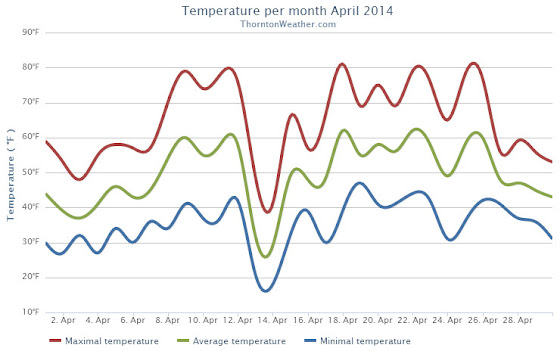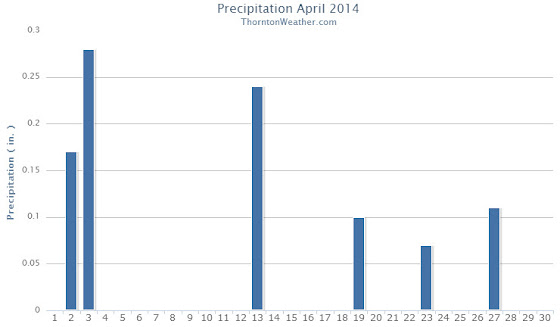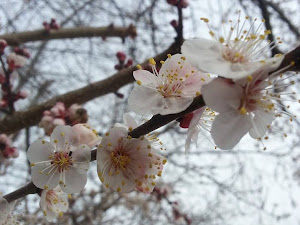
This week in Denver weather history shows the extremely wide variety of conditions we can have this year. From major snow storms to hail dropping thunderstorms, we can see it all.
From the National Weather Service:
24-26
In 1924…post-frontal rain changed to snow… Which became heavy and totaled 10.2 inches over downtown Denver. The greatest amount of snow on the ground was 6.0 inches on the 25th due to melting. North winds were sustained to 38 mph with gusts to 42 mph on the 24th.
25-26
In 1985…a spring storm brought much rain and snow to metro Denver. The foothills were buried with 15 inches of snow at Conifer and 12 inches at Evergreen. At lower elevations… An inch or more of rain fell in Denver and Boulder. The heavy precipitation caused brief power outages in the Denver area. Precipitation totaled 1.06 inches at Stapleton International Airport…including only 0.7 inch of snowfall.
25-27
In 1877…snow ended around 7:00 am on the morning of the 27th… After falling continuously for 48 hours and totaling an estimated 13 inches in the city. The storm…likely accompanied by strong winds…caused trains to be delayed for 2 to 3 days. One or two roofs of small buildings were crushed by the weight of the snow…and many tree branches were broken in the city. There were a number of reports of livestock losses. One stockman lost 17 horses and several cattle from the snow and cold. Precipitation totaled 1.30 inches from the storm.
26
In 1965…while only 0.40 inch of rain fell at Stapleton International Airport…some communities in the foothills west of Denver reported over 30 inches of snow from the storm.
In 1972…a spring snow storm accompanied by thunder dumped 15.8 inches of heavy wet snow on metro Denver. Strong northwest winds gusting to 35 mph produced blowing snow. The storm was quite intense and greatly hampered travel. High winds caused drifts 10 to 15 feet deep in some areas… Blocking roads and stranding hundreds of motorists. An estimated 500 to 600 people were stranded in the Castle Rock area. Rescue service was provided by heavy army equipment from Fort Carson. Power lines were downed…power poles were toppled…and a number of steel towers carrying high voltage power lines were downed. Some areas northeast of Denver were without power for a week. A large number of cattle and sheep were killed by the storm. The greatest snow depth on the ground at Stapleton International Airport was 12 inches. Warm temperatures following the storm quickly melted the snow.
In 1995…the third major snow storm of the month dumped heavy snow in and near the Front Range foothills. Six to 12 inches of heavy wet snow fell in the western metro suburbs with the heaviest amounts above 6 thousand feet. Both Boulder and Golden measured 10 inches of snow. Only 2.4 inches of snowfall were measured at the site of the former Stapleton International Airport. North winds gusted 28 mph at Denver International Airport.
In 1998…the last in a series of April storms blanketed the foothills with heavy snow. Snowfall amounts included: 17 inches near Blackhawk…15 inches at Idaho Springs… 14 inches at Georgetown…11 inches near Conifer and Morrison. Only a trace of snow fell at the site of the former Stapleton International Airport. North winds gusted to 28 mph at Denver International Airport.
26-27
In 1906…rain changed to heavy snow overnight and totaled 7.0 inches over downtown Denver. North winds were sustained to 16 mph on both days. Precipitation totaled 2.16 inches.
In 1932…the temperature remained below freezing for more than 30 consecutive hours. For about 4 of those hours the temperature hovered around 24 to 25 degrees. At this time some early cherry trees were in bloom and apple and lilac blossoms were beginning to open. The leaves of many plants were partly unfurled and vegetation in general was correspondingly advanced due to the warm weather from the 11th to the 22nd. However…there was little apparent injury to foliage and blossoms…but some of the early cherry and apple blossoms were injured. Rain changed to snow on the 26th and continued intermittently through the 27th. Snowfall totaled only 2.0 inches and northeast winds gusted to 22 mph on the 26th.
In 1964…strong winds caused damage to buildings…trees… And power lines. Sustained winds of 37 mph with gusts of 50 to 60 mph were recorded in metro Denver. West-northwest winds gusted to 44 mph at Stapleton International Airport on the 26th.
27
In 1955…west winds at 43 mph with gusts as high as 55 mph were recorded at Stapleton Airport where blowing dust briefly reduced the visibility to 3/8 mile.
In 1966…a northwest wind gust to 51 mph was recorded at Stapleton International Airport.
27-28
In 1919…rainfall totaled 2.03 inches for the two days… Along with a trace of snowfall. Northwest winds were sustained to 24 mph with gusts to 26 mph on the 27th.
In 1975…high winds gusting to 85 mph severely damaged a mobile home in Boulder and caused other minor damage. West winds gusted to 46 mph at Stapleton International Airport on the 28th.
In 1996…heavy snow fell over portions of the Front Range foothills west of Denver. Snowfall amounts ranged from 4 to 7 inches. Only 0.3 inch of snow fell at the site of the former Stapleton International Airport. North winds gusted to 41 mph at Denver International Airport on the 27th.
28
In 1894…southwest winds were sustained to 35 mph with gusts as high as 60 mph.
In 1896…apparent post-frontal bora winds from the northwest were sustained to 43 mph with gusts as high as 56 mph. Rainfall totaled 0.22 inch.
In 1990…high winds raked the northeastern plains and eastern foothills from Boulder north. Wind gusts to 70 mph were recorded in Boulder. West winds gusted to 41 mph at Stapleton International Airport.
In 2001…a 21-year-old man was struck by lightning along the shoulder of I-225 near Parker road. His brother`s car had broken down and he stopped to help. The bolt briefly stopped the man`s heart and caused the right side of his body to go numb.
In 2003…severe thunderstorms produced large hail across southern metro Denver. Hail to 1 3/4 inches in diameter fell in Englewood and 2 miles east of Centennial Airport. Hail as large as 1 1/2 inches in diameter fell in Aurora near Cherry Creek. Other large hail reports included 1 inch hail near Bennett…and 7/8 inch hail in greenwood village and at Centennial Airport.
28-29
In 1950…snowfall totaled 6.3 inches at Stapleton Airport…but only 3.5 inches over downtown Denver.
In 1960…heavy snow fell at Stapleton Airport where 8.6 inches of snow were measured. North winds gusted to 38 mph. Most of the snow…6.9 inches… Fell on the 29th.
29
In 1898…apparent thunderstorm winds were sustained from the southwest to 58 mph with gusts to 66 mph.
In 1909…north winds were sustained to 44 mph behind an apparent cold front. These were the strongest measured winds of the month that year.
In 1962…heavy snowfall totaled 6.4 inches at Stapleton Airport where northeast winds gusted to only 17 mph. Snow fell all day…but the most on the ground was only 1 inch due to melting.
In 1991…two men were struck by lightning while golfing in cherry hills just south of Denver. The two received only minor burns. Shortly afterward…lightning struck a home in Cherry Hills Village several times…leaving numerous holes in the roof. No injuries were reported.
In 1993…localized strong winds occurred at Jefferson County Airport near Broomfield where gusts to 63 mph were recorded. The strong winds were the result of a probable microburst.
In 2000…several severe thunderstorms producing large hail and destructive winds rumbled across northern metro Denver. Thunderstorm wind gusts reached 81 mph near Hudson with hail as large as 3/4 inch in diameter at Longmont. Several homes and vehicles sustained damage. The strong winds uprooted trees and downed utility poles…causing scattered outages. Lightning sparked a house fire in Boulder. The fire damaged a portion of the roof and a bedroom on the third floor. Thunderstorm winds gusted to 53 mph at Denver International Airport.
In 2003…lightning struck a chimney at a residence in Hiwan in Evergreen…sending stones flying as far as 150 feet. Electrical equipment in some nearby homes also failed. Damage to the residence…in addition to electrical equipment…was estimated at 100 thousand dollars. Severe thunderstorms produced large hail to 1 inch in diameter near Hudson and Sedalia and to 3/4 inch near Parker. Hail as large as 1 3/4 inches was measured 9 miles north of Sedalia.
In 2014…high winds occurred east of interstate 25. Peak wind gusts included: 71 mph just north of Strasburg; 68 mph at Denver International Airport; 62 mph near Elizabeth; 58 mph at Front Range airport in Watkins and 11 miles east of Parker.
Continue reading April 26 to May 2: This week in Denver weather history




